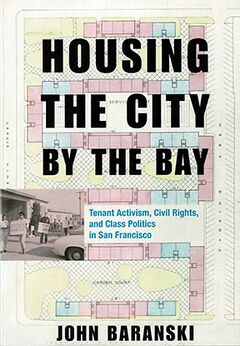Neoliberalism Dismantles Public Housing
Historical Essay
by John Baranski
This excerpt originally appeared in "All Housing is Public," Chapter Seven of Housing the City by the Bay: Tenant Activism, Civil Rights, and Class Politics in San Francisco (see below for copyright and book information)
The New Right’s vision of dismantling the economic and civil rights built up in previous decades and shrinking the public sector—except for military and prison industrial complex spending—was in line with a public philosophy known as neoliberalism. Neoliberalism celebrates individual responsibility and self-sufficiency over the welfare state and a global, free market economy liberated from government restraints. As it evolved in the 1970s, neoliberalism also embodied a belief in tougher criminal sentencing laws and more military spending. In 1980, the election of the New Right presidential candidate Ronald Reagan sharpened and broadened the neoliberal attack on government and the civil and economic rights of citizens. Once in office, Reagan slashed taxes and social programs, particularly urban programs, which he believed created dependency among residents and institutions alike. He deregulated industries, weakened worker rights, and further devolved federal programs to state and local government and the private sector.(46)
President Ronald Reagan and his Secretary of Housing and Urban Development Samuel Pierce.
Photo: US Presidential History
Reagan appointees shared his philosophy. To lead HUD, Reagan appointed Samuel Pierce. A former Wall Street lawyer and New York State assistant attorney, Pierce came to the position with little background in or commitment to improving affordable housing. Housing scholar Robert Allen Hays described Pierce as “one of the least aggressive advocates of housing for the poor to be found in the black community.” Pierce reduced HUD staff, and he and other high-level appointees pushed to change HUD’s institutional culture to match Reagan’s vision of smaller government. Housing experts Charles Moore and Patricia Hoban-Moore, who worked and consulted for HUD, noted that Reagan’s HUD appointees “were people who were not just inexperienced or bad managers, but they were also ideologically hostile to the very programs they were responsible for managing.” And many, including Pierce, were soon associated with corruption and misuse of HUD funds.(47)
Another way the Reagan administration undermined public housing was by producing what was presented as new knowledge to reduce public support for government housing and economic and civil rights. In April 1982, the first of several housing reports came out of the Reagan administration. Written by a committee composed almost entirely of real estate representatives, the 277-page President’s Commission on Housing report affirmed “the genius of the market economy, freed of the distortions forced by government housing policies and regulations.” As well, it claimed, the private sector “can provide for housing far better than Federal programs.” A few months later, HUD’s urban policy report similarly emphasized the need to cut urban programs, based on the position that these programs did more harm than good to recipients.(48)
The 1982 federal budget halved the previous year’s housing funding, and in 1983 the administration tried to put forward a housing budget that would have authorized no new units and a $2.5 billion reduction from 1982 levels. Congress pushed back, and housing appropriations increased slowly in the following years. Significantly, the allocation of HUD funding favored Section 8 and for-profit and nonprofit housing legislation. The only kind of public housing funding to increase was for seniors and people with disabilities.(49) At a 1985 Urban League conference, few in the audience were likely surprised when a HUD deputy assistant secretary said, “We’re basically backing out of the business of housing, period.”(50)
This “backing out of the business of housing” meant less federal funding for housing authorities and fewer protections for tenants. HUD, along with state and local governments, increased support for the nonprofit housing sector, which won contracts to provide low-cost housing to tenants who previously would have been in public housing. By 1990, nonprofits built and managed 17 percent of all HUD low-income housing.(51) In the area of fair housing, the Department of Justice and HUD limited the collection of race and gender data necessary for identifying discrimination and segregation, and they did not pursue violations of the fair housing provisions of the 1968 Civil Rights Act with the same vigor as had previous administrations.(52) These policies squared with Reagan’s promises to scale back the government’s role in the economy and civil rights, and they were part of a larger set of regressive policies that shored up the wealth and power of landlords and bosses. Importantly, his housing policies often built on HUD policies piloted since the 1960s and left housing authorities with even fewer resources to maintain already struggling programs.
previous article • continue reading
Notes
46. Biles, The Fate of Cities, chapter 8. Hays, The Federal Government and Urban Housing; Schwartz, Housing Policy in the United States. For a sample of New Right scholarship, see Jon F. Hale, “The Making of the New Democrats,” Political Science Quarterly 110, 2 (January 1995): 207–32; Margaret Weir, ed., The Social Divide: Political Parties and the Future of Activist Government (Washington, DC: Brookings Institution Press, 1998); Lisa McGirr, Suburban Warriors: The Origins of the New American Right (Princeton, NJ: Princeton University Press, 2001); Sean Wilentz, The Age of Reagan: A History, 1974–2008 (New York: HarperCollins, 2008); Bruce J. Schulman and Julian E. Zelizer, eds., Rightward Bound: Making Conservative America in the 1970s (Cambridge, MA: Harvard University Press, 2008); David Harvey, A Brief History of Neoliberalism (Oxford: Oxford University Press, 2007); John Arena, Driven from New Orleans: How Nonprofits Betray Public Housing and Promote Privatization (Minneapolis: University of Minnesota Press, 2012).
47. Hays quote on Pierce in his The Federal Government and Urban Housing, chapter 8, on 234. Chester Hartman, “Housing Policies Under the Reagan Administration,” in Rachel G. Bratt, Chester Hartman, and Ann Meyerson, eds., Critical Perspectives on Housing (Philadelphia: Temple University Press, 1986); Charles Moore and Patricia Hoban-Moore, “Some Lessons from Reagan’s HUD: Housing Policy and Public Service,” Political Science and Politics 23, 1 (March 1990): 13–18.
48. Quote in Biles, The Fate of Cities, 259. The President’s Commission on Housing, the Report of the President’s Commission on Housing (Washington, DC, 1982); Hartman, “Housing Policies Under the Reagan Administration.”
49. Hartman, “Housing Policies Under the Reagan Administration”; Hays, The Federal Government and Urban Housing; Moore and Hoban-Moore, “Some Lessons from Reagan’s HUD”; Update (December 1982).
50. Quoted in Hartman, “Housing Policies Under the Reagan Administration,” 384.
51. The largest HUD non-public housing programs from 1960 to 1990 were Section 8, Section 202, Section 236, Section 502, Section 515, and community development block grants. Katherine O’Regan and John Quigley, “Federal Policy and the Rise of Nonprofit Housing Providers,” Journal of Housing Research 11, 2 (2000): 297–317; Schwartz, Housing Policy in the United States, chapter 9.
52. SFHA, Crisis in Public Housing: A Review of Alternatives for Public Housing in San Francisco and Recommendations for the Future (April 1982); Hartman, “Housing Policies Under the Reagan Administration”; Julee H. Kryder-Coe, Lester M. Salamon, and Janice M. Molnar, eds., Homeless Children and Youth: A New American Dilemma (New Brunswick, NJ: Transaction, 1992), 208; Biles, The Fate of Cities; Lawrence J. Vale, Purging the Poorest: Public Housing and the Design Politics of Twice-Cleared Communities (Chicago: University of Chicago Press, 2013); Arena, Driven from New Orleans.

Excerpted from Housing the City by the Bay: Tenant Activism, Civil Rights, and Class Politics in San Francisco by John Baranski, published by Stanford University Press. Used by permission. © Copyright 2019 by John Baranski. All rights reserved.

